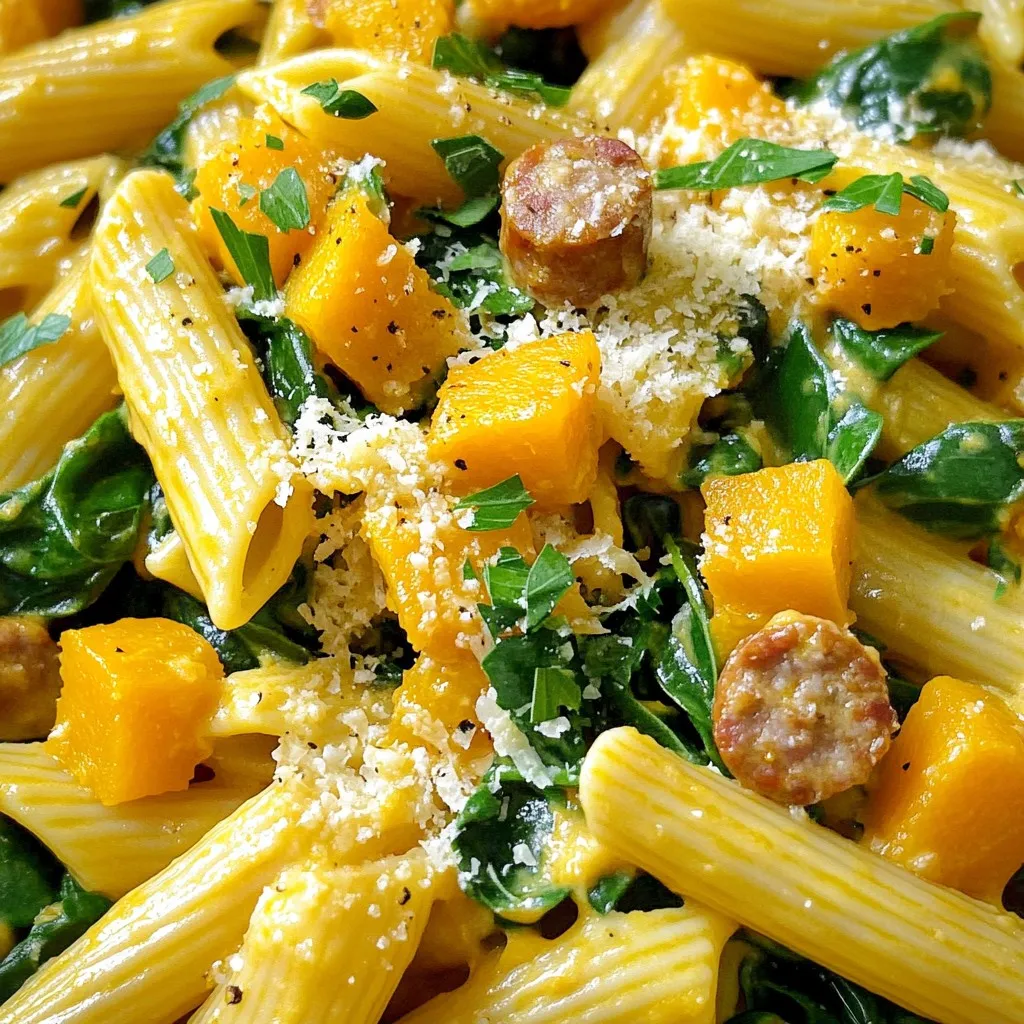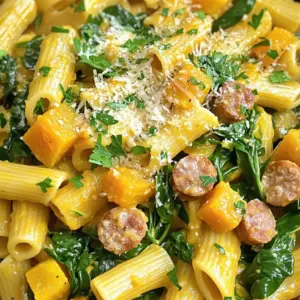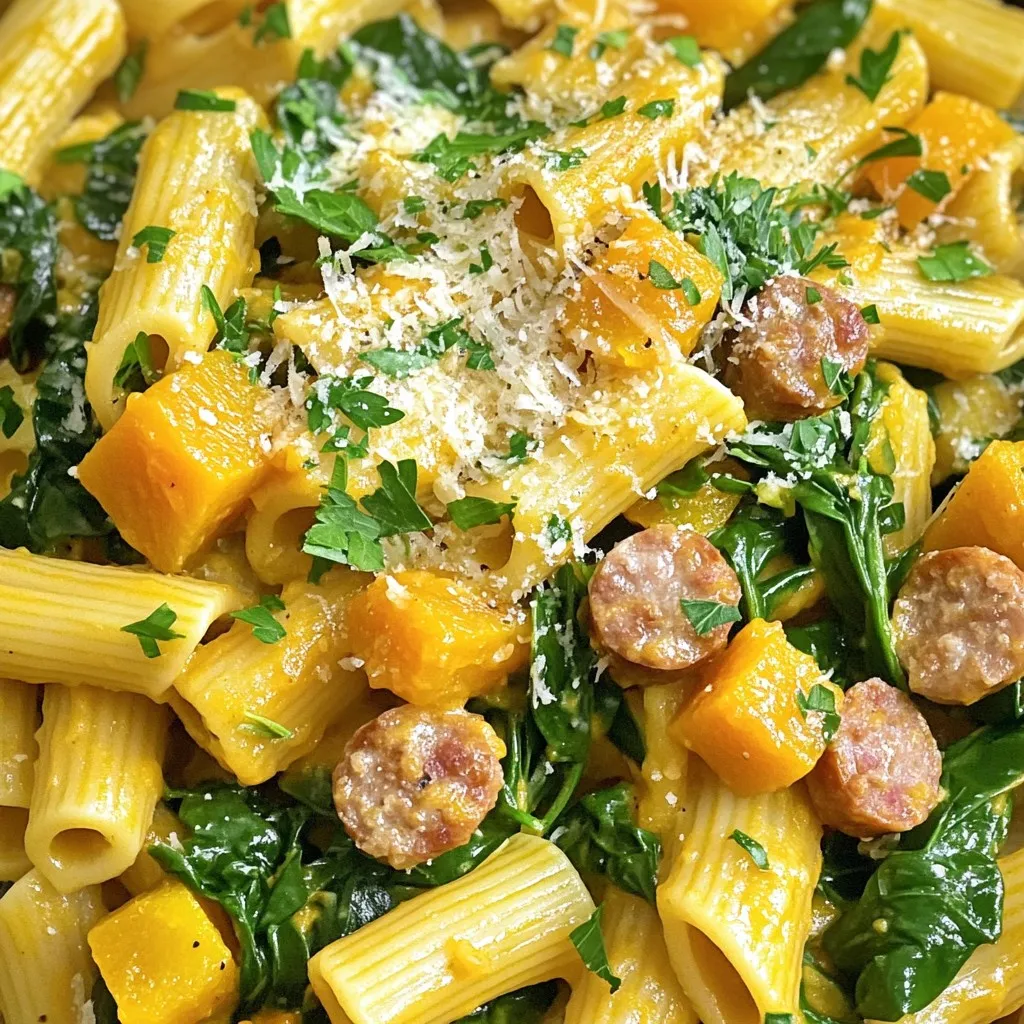Fall is here, and it’s time to cozy up with a warm, hearty meal! Our Autumn Sausage Squash Pasta combines the rich flavors of Italian sausage and seasonal butternut squash for a delightful dish. Whether you crave something mild or spicy, this recipe caters to all. Get ready to explore simple steps and tips to transform your kitchen into a fall haven. Let’s make this tasty seasonal dish together!
Ingredients
Main Ingredients
– 8 oz pasta (choose penne or fusilli for best texture)
– 1 lb Italian sausage (select mild or spicy based on preference, casings removed)
– 1 medium butternut squash, peeled and cubed (about 4 cups)
– 2 cups fresh spinach (packed)
– 2 cloves garlic, minced
– 1 small onion, diced
In this recipe, you can choose between penne or fusilli pasta. Both types hold sauces well, making each bite flavorful. For protein, Italian sausage adds richness. You can pick mild or spicy, depending on how much heat you want. The star of this dish is butternut squash. Its sweetness contrasts nicely with the savory sausage. Fresh spinach adds a pop of color and nutrients. Garlic and onion provide a solid flavor base, making every bite delicious.
Additional Ingredients
– 1 teaspoon dried thyme
– 1 teaspoon dried sage
– 1/2 teaspoon red pepper flakes (optional for added heat)
– 1/4 cup heavy cream (or substitute with coconut cream for a dairy-free option)
– 1/2 cup grated Parmesan cheese (or nutritional yeast for a dairy-free alternative)
– 2 tablespoons olive oil
– Salt and pepper to taste
– Fresh parsley, chopped, for garnish
Herbs and spices elevate the flavors. Thyme and sage bring warmth. Red pepper flakes add a little kick if you like it spicy. For creaminess, you can use heavy cream or coconut cream. Parmesan cheese gives a savory depth, but nutritional yeast works well for a dairy-free version. Olive oil helps with cooking and adds flavor. Always season with salt and pepper to enhance all the tastes. Finally, fresh parsley makes for a pretty garnish and adds a fresh touch.
Step-by-Step Instructions
Cooking the Pasta
Start by bringing a big pot of salted water to a boil. Add 8 oz of penne or fusilli pasta. Cook it until it is al dente, as per the package instructions. Once done, drain the pasta. Be sure to save about 1 cup of the pasta water for later.
Roasting the Squash
Next, preheat your oven to 400°F (200°C). Peel and cube your butternut squash. In a mixing bowl, toss the cubes with 1 tablespoon of olive oil. Add salt and pepper to taste. Spread the squash on a baking sheet. Roast it for 20-25 minutes. Look for a nice caramelized color and tenderness.
Sautéing the Aromatics
While the squash roasts, grab a large skillet and place it over medium heat. Add 1 tablespoon of olive oil. Once hot, toss in the diced onion. Sauté for about 3 minutes until it turns soft and translucent. Then, add in 2 cloves of minced garlic. Stir for another minute to avoid burning.
Browning the Sausage
Now, raise the heat to medium-high. Add 1 lb of Italian sausage to the skillet. Use a spatula to break it apart. Cook until it is browned and fully cooked, for about 5-7 minutes. Mix in 1 teaspoon each of dried thyme and dried sage. If you like a kick, add 1/2 teaspoon of red pepper flakes.
Combining All Ingredients
After browning the sausage, gently fold in the roasted butternut squash. Then toss in 2 cups of fresh spinach. Allow the spinach to wilt for about 1-2 minutes. Stir frequently to mix everything well.
Mixing and Serving
Lower the heat to medium-low and pour in 1/4 cup of heavy cream. Stir to combine. If your sauce is too thick, add small amounts of the reserved pasta water until it reaches the right consistency. Next, add the drained pasta to the skillet. Toss everything together so every piece is coated. Taste and add more salt and pepper if needed.
To serve, stir in 1/2 cup of grated Parmesan cheese. This will melt into the dish and add creaminess. Portion the pasta into bowls. You can drizzle a bit more cream on top if you like. Finish with a sprinkle of fresh parsley and more cheese for a nice touch.
Tips & Tricks
Perfecting the Dish
To cook pasta al dente, follow these steps:
– Use a large pot of boiling, salted water.
– Add pasta and stir right away to prevent sticking.
– Check the package for cooking time and taste a piece a minute or two early. It should be firm yet tender.
Balancing flavors is key. Use fresh herbs like thyme and sage to enhance the dish. Dried herbs work well too. Add red pepper flakes for a touch of heat, if you like spice. Taste as you go. Adjust salt and pepper to suit your palate.
Enhancements
For added richness, consider these optional ingredients:
– A splash of white wine for depth.
– Toasted nuts like pine nuts or walnuts for crunch.
– A dollop of crème fraîche for a tangy twist.
These ingredients can elevate your dish and bring in new flavors.
Presentation Ideas
How you serve food matters. Here are some ideas for an appealing presentation:
– Use wide bowls for the pasta to showcase the colors.
– Drizzle a little heavy cream on top for a beautiful effect.
– Sprinkle fresh parsley and extra Parmesan cheese on top.
These simple touches make your dish look gourmet and inviting.

Variations
Vegetable Substitutions
You can switch up the vegetables in this dish. Kale or Brussels sprouts work well. They add great flavor and nutrition. Just chop them and toss them in when you add the spinach. They will cook down nicely and blend in well.
Dietary Adjustments
Want to make this dish vegan? Use plant-based sausage instead of Italian sausage. Swap the heavy cream for coconut cream or a nut-based cream. For a gluten-free option, choose gluten-free pasta. Both adjustments keep the dish tasty and satisfying.
Flavor Tweaks
To add more flavor, consider adding nuts or lemon zest. Chopped walnuts or pine nuts give a nice crunch. A sprinkle of fresh lemon zest brightens the dish. Just add these at the end for the best taste. These tweaks can make your pasta even more delightful!
Storage Info
Storing Leftovers
To store leftovers, let the pasta cool first. Place it in an airtight container. This keeps it fresh for later. Refrigerate it for up to three days. If you want to keep it longer, freeze it! Divide the pasta into smaller portions. Use freezer-safe bags or containers. Make sure to squeeze out the air before sealing. This helps prevent freezer burn.
Reheating Tips
When you’re ready to eat the leftovers, reheating is key. Use a skillet for the best results. Add a splash of water or broth to the skillet. Heat over medium-low heat and stir often. This keeps the pasta moist and tasty. You can also use the microwave. Put the pasta in a microwave-safe bowl, cover it, and heat in short bursts. Stir between each burst to ensure even heating.
Shelf Life
For safe consumption, follow this timeline:
– Refrigerated: 3 days maximum.
– Frozen: Up to 2 months is best.
After these times, the taste and texture may change. Always check for signs of spoilage before eating. Enjoy your delicious Autumn Sausage Squash Pasta again!
FAQs
Can I use a different type of pasta?
Yes, you can use different pasta types. Try using gluten-free pasta for a safe option. You can also choose spaghetti, rotini, or even whole wheat pasta. Each type offers a unique texture. Just cook it according to the package instructions.
How do I make this dish dairy-free?
To make this dish dairy-free, swap heavy cream for coconut cream. For cheese, use nutritional yeast instead of Parmesan. These options keep the dish creamy and flavorful. You won’t miss the dairy at all.
Can I make it ahead of time?
Yes, you can prep this dish in advance. Cook the pasta and roast the squash ahead of time. Store them separately in the fridge. When you’re ready to eat, combine everything in a pan. Heat it gently until warm.
What can I serve with Autumn Sausage Squash Pasta?
This dish pairs well with a simple green salad. A fresh spinach salad or arugula works great. You could also serve garlic bread for a hearty meal. Roasted vegetables add color and flavor too.
This blog post provided a detailed guide to making Autumn Sausage Squash Pasta. We explored main ingredients like pasta types, protein choices, and seasonal vegetables. Then, we walked through step-by-step instructions for cooking, combining flavors, and serving. Tips for success and variations were shared for personalized touches. Finally, I covered storage and reheating best practices to keep your dish fresh.
Now you can enjoy a hearty and delicious meal, while having fun experimenting in the kitchen!

